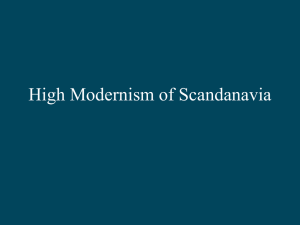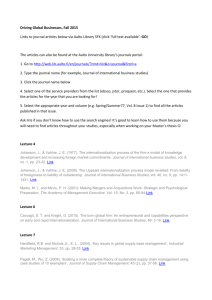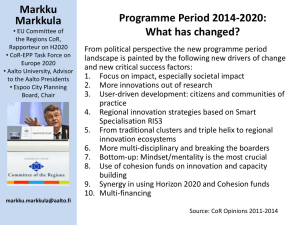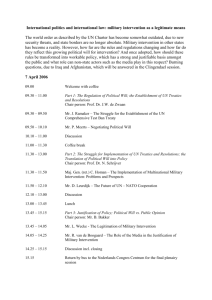The Emergence of Modernism
advertisement
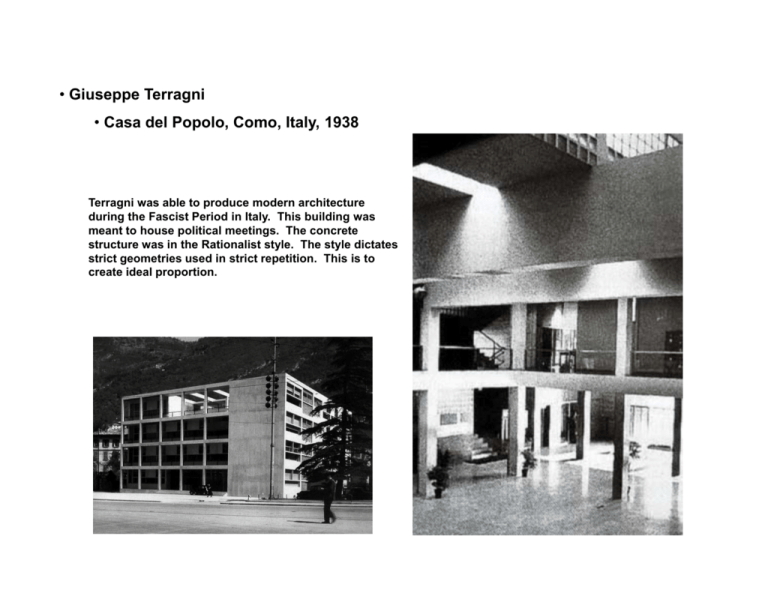
• Giuseppe Terragni • Giuseppe Terragni • Casa del Popolo, Como, Italy, 1938 • Casa del Popolo 1938 Terragni was able to produce modern architecture during the Fascist Period in Italy. This building was meant to house political meetings. The concrete structure was in the Rationalist style. The style dictates strict geometries used in strict repetition. This is to create ideal proportion. • Willem Dudok • Town Hall 1924-30 Dudok created this modern town hall in a the small Dutch town of Hilversum. It’s rigid lines & strict geometries create a strong presence on the countryside. The Council Chamber has a dignified presence created by the modern materials. The use of rich materials & vivid colors create a warm space prominent space. Town Hall - Council Chamber Town Hall - exterior • Marcel Breuer Breuer upon the closing of the Bauhaus fled to England. He became not only a successful architect but also an industrial designer. Here we see the furniture he developed for mass production for the Isokon. Both Breuer & Alvar Aalto were the forerunners of bentwood furniture. Plywood Long Chair • Alvar Aalto (1898 – 1976) • Turun Sanomat - 1927 Sanomat - Exterior Aalto designed this industrial building to house a newspaper and its printing facility in the city of Turku. The Concrete structure is influenced by the Art Deco style. This is evident in the column forms. The ceiling was sealed to give it a shiny finish. Sanomat - Warehouse • Alvar Aalto (1898 – 1976) • Turun Sanomat - 1927 Sanomat - Warehouse The Lobby was sealed concrete & Plaster walls with tile floors. Again the Art Deco style comes through. This is one of the better concrete structures in all of Europe. Sanomat – Office Lobby Dilletantes Rose Cumming, Elsie de Wolfe, Ruby Ross Wood, and Dorothy Draper pioneered the profession of interior decoration; by the 1930s the profession became more formalized – the American Institute of Interior Decorators (now the ASID) was established in 1931. Dorothy Draper, room for the Quitandinha Hotel, Brazil, 1946 Rose Cummings, bedroom, 1946 David Hicks, Drawing Room, London, 1954 David Hicks, bathroom, late 1960s • Le Corbusier • Notre Dame Du Haut, Ronchamp, France (1950-1954) Corbu was influenced very much by the surrealist artists of the 20th century. Artists such as Dali, Joan Miro and especially Victor Brauner. Corbu himself was a painter and was very much intertwined with this movement. His architecture takes on the same quality as the artistic movement with its dream-like displacements of form and it incongruous forms. After World War II, France had to rebuild yet again. This Church in the French Country side was an expression of modern ideas rather than past rigidity. To Corbu this church was a sculpture depicting the mysticism of faith. • Le Corbusier • Notre Dame Du Haut, Ronchamp, France (1950-1954) Corbu used a new material to create the wall finishes. It was a spray on concrete. It allowed for a smooth finish on the curvilinear walls. Corbusier was fascinated with nautical themes. It is believed the building is a representation of the Noah’s Ark. Bring a flock together to provide a safe harbor from the tumultuous storm. The cleft wall however displays Egyptian influences like similar walls at the Temple of Carnac. The ceiling was built so that it floats freely above the walls allowing a sliver of light. Its huge form is hollow. This adds to the level of mysticism of the space. • Le Corbusier • Notre Dame Du Haut, Ronchamp, France (1950-1954) The space becomes a dark solemn prayer chamber for weekly services. Corbu studied the angles of the sun such that on certain Christian holidays, the angle of the sun would specifically light one of the carved out windows such that its stained glass would project into the chamber. All the windows are based on these sun angles. • Alvar Aalto (1898 – 1976) • Paimio Sanitorium - 1929 - 1933 In designing this hospital, Aalto began to look at the human condition. The design was based on how human’s heal. This was truly a case where form followed function. The Sprawling building stretches out & creates courtyards which allow natural light into all rooms. Nature blends its way from exterior to interior throughout this building with all of its roof decks. It was Aalto’s belief that nature was truly necessary to heal oneself. Sanitorium – Exterior Sanitorium – Plan • Alvar Aalto (1898 – 1976) • Paimio Sanitorium - 1929 - 1933 Aalto also believed that bright colors made people feel better and be more active. Psychological tests proved this to be true. So the lobby was treated with Bright yellow walls and floor tiles to offset the white. Blue was used as an accent. Sanitorium – Stair Sanitorium – lobby • Alvar Aalto (1898 – 1976) • Paimio Sanitorium - 1929 - 1933 Aalto studied rigorously the effects of lighting & heating on the infirmed. The diagrams show the interplay of natural & artificial light. The beds designed by Aalto were designed to be flexible. The spaces were designed for being horizontal. The ceiling colors were darker to give the patient a more restful color to look at. Even the bent wood chair had its purpose. It was designed to put a person at the correct angle to enhance their breathing. Sanitorium – chair Sanitorium – diagrams • Alvar Aalto (1898 – 1976) • Villa Mairea - 1938 - 1941 One of Aalto’s most impressive buildings. In it Aalto combined many different materials to create diverse forms. The Finish culture is extremely in tune with nature. Aalto’s work highlights this through the use of natural materials & Organic forms. Also design elements such as the pool and the rubble masonry wall add to the aesthetic. Villa Mairea - Exterior Villa Mairea - Plan • Alvar Aalto (1898 – 1976) • Villa Mairea - 1938 - 1941 Aalto uses wood ceilings and floors. The walls are plaster. All the furniture is designed by Aalto as well. Again, he likes to bring nature into the building. At the fireplace, Aalto carves out an opening that allows him to add a window and create a shelf. The form is as if it had been eroded away over time. Villa Mairea - Entrance Villa Mairea – Living Room • Alvar Aalto • Finish Pavilion 1939, New York This was Aalto’s chance to display his works for the world. This opened up modernism to a less industrial direction. This was example of breaking from the past, using modern materials and creating something of a machined aesthetic. His use of curves helped free up Modernism from the more rigid to the more fluid. This was about expression and connectivity with nature. Arguably the most influential piece of architecture ever displayed at a Worlds fair. • Alvar Aalto • Finish Pavilion 1939, New York Within this pavilion, Aalto designed all the light fixtures, furniture, and had a hand in the graphic design. This allowed him to display his bent plywood furniture that he had developed in Europe for many years. The pavilion meant to display the nature of Finland and it’s people, is a mixture of reinforced concrete, metal, and wood. Aalto sets off his curved walls with light fixtures in coves to help accent the curves. • Frank Lloyd Wright • Taliesin West (1937-1959) Frank Lloyd Wright was one of the first Modern “Green” Designers. He understood nature and natural light and how to manipulate them for active and passive control of temperature within his buildings. He recycled local materials excavated from the construction for use in his buildings. This level of conservation had not been seen by this point except for in the utilitarian architecture of Aboriginal cultures across the globe. • Frank Lloyd Wright • Taliesin West (1937-1959) Developed as the winter home for Wright and his school. Every year his interns and himself would pack up their shop in Wisconsin load it into their cars and drive across country to the desert of Arizona to take up residence for the winter and learn more about architecture. It was a very communal experience. The interns received no pay yet worked on all of Wright’s projects. They did all the chores around the complex. In the 1950’s during the age of McCarthyism, Wright was questioned whether his school was communist. Luckily for him his brash nature fended off his native statesmen. Charles and Ray Eames house, Santa Monica, California, 1948 Gordon Bunshaft, Skidmore, Owings & Merrill (SOM) Interior of the Connecticut General Life Insurance Company, Bloomfield, Connecticut, 1957 Ward Bennett and Davis Allen, Skidmore, Owings & Merrill (SOM) – Office for David Rockefeller, Chase Manhattan Bank, 1961 • Kurd Alsleben • Open Office Plan As furniture designs evolved in the modern era, new methods of arrangement were experimented with. In this 1968 plan, we see a very organic arrangement of moveable office equipment. The curving lines depict the path of travel an employee would take to get to their desk. Companies like Knoll, Herman Miller, & Steelcase designed their furniture to fit the new open plan aesthetic. • Herman Miller • Systems Furniture Proposed office Plan Designs by Robert Propst, Bill Strumpf, & Neils Different helped create the first systems furniture & Ergonomic chairs on the market. The forerunners of what we have currently. Systems furniture allows flexibility within an open plan to allow the worker to have her or his own office without traditional walls. The system can be pieced together on modules. The modules can be pieced together to create a hierarchy of spatial types. The panels can be treated with foam and Fabric to create acoustical barriers, the panels can be treated with Fiberglass and become translucent. These same systems exist today in mass. • Richard Neutra • Kaufmann House, 1946-7 Palm Springs, Ca. This later work by Neutra helped to establish the Palm Springs aesthetic. This aesthetic became synonymous with such stars as Frank Sinatra, Dean Martin, Sammy Davis Jr., & Bob Hope. The house was developed to afford views to the owner of the California Desert. This gave the opportunity for the design to have sliding glass walls to allow natural ventilation with the dry desert air. The floors were of sandstone. The surfaces of the space were very simple. The lines that were created were sleek. Its this level of minimalism that became the frame for the desert views. The Ascension of Modernism • Eero Saarinen • Kresge Chapel, 1952-1956 Boston, Ma. The building on the campus of MIT in Boston, was to house a nondenominational chapel for its students. Saarinen designed it to be a perfect cylinder of red brick. This was to not give preference to any one religion. One entered through a front arch. The building was surrounded by a moat/reflecting pool that was used to help light the building at night. The oculus of the building shines light down onto the alter. A bronze sculpture by Bertoia provides the backdrop, reflecting light off of its small bronze panels. Saarinen designed all the chairs for the space. Kaufmann House – Living Room The Ascension of Modernism • Eero Saarinen • TWA Terminal, 1956-1962 New York, Ny. The building designed to be the embodiment of flight. Saarinen developed the form with reinforced concrete. Its expressive forms allow the building to stand out against its contemporaries. The fluid nature of concrete was pushed to the extreme in creating the bird-like forms. The concrete also made a solid choice since the building would be subject to millions of travelers a year. The materials had to be durable. TWA Terminal – exterior The Ascension of Modernism • Eero Saarinen • TWA Terminal, 1956-1962 New York, Ny. The interior was a series of concrete arches overlapping and coming to the ground. Every element within the space tied into the design. The ticket desks were concrete sculptures. It is very organic and fluid. From the interior you even get the impression that the building is rising up to take flight. TWA Terminal – interior The Ascension of Modernism • Frank Lloyd Wright • The Guggenheim Museum (1943-1956) • New York City, NY. The last major work of Wright’s before his death. The building took 16 years to construct due to the many revisions. The forms are concrete both sprayed on and cast. The idea was to create a museum that would rival all other in America. There were many concerns due to the sloping curved exhibition space. The central exhibition hall is lighted by a skylight from above. Guggenheim - Exterior The Ascension of Modernism • Frank Lloyd Wright • The Guggenheim Museum (1937-1959) • New York City, NY. The continuous curved ramps are the exhibition space. The 8 floors varies in size ideal to display everything from sculpture to paintings. At the request of the curator, Wright added a wing to the side to increase the amount of display space. The projects many revisions created a love/hate relationship between Guggenheim & Wright. Guggenheim wanted the best architect to design his museum but was frustrated with Wright as a person. In the end, Guggenheim received a world renowned building. Guggenheim - Interior The Ascension of Modernism • Frank Lloyd Wright • The Guggenheim Museum (1937-1959) • New York City, NY. The slow promenade up the main exhibit hall at times has been considered tiresome by some patrons. There has been problems hanging certain pictures due to the frames. Wright designed indirect light fixtures to create a soft even glow for the spaces. His initial vision was to due the building out of white marble. Guggenheim - Interior Modern Furniture Thonet Bentwood Rocker, 1860 Thonet Design No. 18, 1876 Thonet Armchair No. 9, 1876 Marcel Breuer, Cecsa side chair, 1925 Marcel Breuer, Cecsa arm chair, 1925 Marcel Breuer, Wassily chair, 1925 Mies van der Rohe, The MR Chair, 1926 Mies van der Rohe, The Barcelona Chair, 1929 Mies van der Rohe, The Barcelona Chair, 1929 Mies van der Rohe, The Brno Chair, 1930 Mies van der Rohe, The Tugendhat Table, 1930 Le Corbusier, Chaise Lounge 1928 Le Corbusier, The Basculant Chair, 1928 Le Corbusier, The Grand Confort Petit, 1928 Alvar Aalto, the Vilpuri (for his Vilpuri Library) stacking stool, 1933 Alvar Aalto, the Paimio arm chair, 1933 Alvar Aalto, the cantilevered arm chair, 1933 Hans Wegner, The Peacock Chair, 1947 Hans Wegner, The Classic Chair, 1949 Charles Eames Plywood Chair, 1946 Charles Eames Plastic Shell Chair, 1948 Charles Eames Lounge Chair, 1956 Charles Eames Lounge Chair, 1956 Charles and Ray Eames Stacking Chair, 1955 Charles and Ray Eames Shell Chair, 1951 Charles Eames Aluminum Chair, 1958 Charles Eames and Eero Saarinen – competition entry for a chair design made of molded fiberglass, 1940 Eero Saarinen – Pedestal chair, 1955 Eero Saarinen pedestal chair, 1957 Eero Saarinen pedestal arm chair, 1957 Eero Saarinen pedestal table, 1957 Table by Isamu Noguchi, for Herman Miller, 1944
